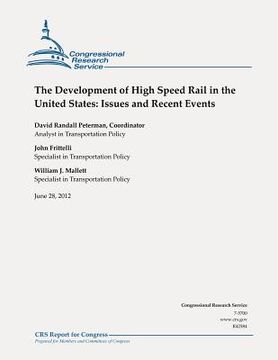Compartir
The Development of High Speed Rail in the United States: Issues and Recent Events (en Inglés)
John Frittelli
(Autor)
·
William J. Mallett
(Autor)
·
David Randall Peterman
(Autor)
·
Createspace Independent Publishing Platform
· Tapa Blanda
The Development of High Speed Rail in the United States: Issues and Recent Events (en Inglés) - Frittelli, John ; Mallett, William J. ; Peterman, David Randall
$ 53.215
$ 56.015
Ahorras: $ 2.801
Elige la lista en la que quieres agregar tu producto o crea una nueva lista
✓ Producto agregado correctamente a la lista de deseos.
Ir a Mis Listas
Origen: Estados Unidos
(Costos de importación incluídos en el precio)
Se enviará desde nuestra bodega entre el
Lunes 12 de Agosto y el
Lunes 26 de Agosto.
Lo recibirás en cualquier lugar de Argentina entre 1 y 3 días hábiles luego del envío.
Reseña del libro "The Development of High Speed Rail in the United States: Issues and Recent Events (en Inglés)"
The provision of $8 billion for intercity passenger rail projects in the 2009 American Recovery and Reinvestment Act (ARRA; P.L. 111-5) reinvigorated efforts to expand intercity passenger rail transportation in the United States. The Obama Administration subsequently announced that it would ask Congress to provide $1 billion annually for high speed rail (HSR) projects. This initiative was reflected in the President's budgets for FY2010 through FY2013. Congress approved $2.5 billion for high speed and intercity passenger rail in FY2010 (P.L. 111-117), but zero in FY2011 (P.L. 112-10) and FY2012 (P.L. 112-55). In addition, the FY2011 appropriations act rescinded $400 million from prior year unobligated balances of program funding. There are two main approaches to building high speed rail (HSR): (1) improving existing tracks and signaling to allow trains to reach speeds of up to 110 miles per hour (mph), generally on track shared with freight trains; and (2) building new tracks dedicated exclusively to high speed passenger rail service, to allow trains to travel at speeds of 200 mph or more. The potential costs, and benefits, are relatively lower with the first approach and higher with the second approach. Much of the federal funding for HSR to date has focused on improving existing lines in five corridors: Seattle-Portland; Chicago-St. Louis; Chicago-Detroit; the Northeast Corridor (NEC); and Charlotte-Washington, DC. Most of the rest of the money is being used for a largely new system dedicated to passenger trains between San Francisco and Los Angeles, on which speeds could reach up to 220 mph. Plans for HSR in some states were shelved by political leaders opposed to the substantial risks such projects entail, particularly the capital and operating costs; the federal funds allocated to those projects were subsequently redirected to other HSR projects. Estimates of the cost of constructing HSR vary according to train speed, the topography of the corridor, the cost of right-of-way, and other factors. Few if any HSR lines anywhere in the world have earned enough revenue to cover both their construction and operating costs, even where population density is far greater than anywhere in the United States. Typically, governments have paid the construction costs, and in many cases have subsidized the operating costs as well. These subsidies are often justified by the social benefits ascribed to HSR in relieving congestion, reducing pollution, increasing energy efficiency, and contributing to employment and economic development. It is unclear whether these potential social benefits are commensurate with the likely costs of constructing and operating HSR. Lack of long-term funding represents a significant obstacle to HSR development in the United States. The federal government does not have a dedicated funding source for HSR, making projects that can take years to build vulnerable to year-to-year changes in discretionary budget allocations.

